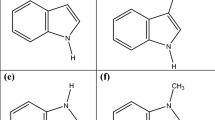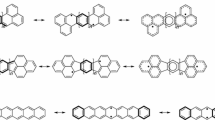Abstract
The low-lying Π states of H2 consist of one core (σ) and one valence (π) electron and afford a direct evaluation of intershell σ-π interaction. After resolution of the electronic energy into σ only, π only, and σ-π parts, it is shown that an electronic change in this model system is due solely to a change in the π electrons. Simple Hückel theory is examined. If the molecular core is represented properly, regardless of the π wave function the calculated α and β parameters are in reasonable agreement with the “empirical” parameters. This agreement appears to be due to a fortuitous cancellation of energy contributions.
Zusammenfassung
Die niedrig liegenden Π-Zustände des H2 bestehen aus einem Rumpfelektron σ und einem Valenzelektron π und ermöglichen eine direkte Auswertung der σ-π-Wechselwirkung zwischen zwei Schalen. Nach der Zerlegung der elektronischen Energie in σ-,π- und σ-π-Anteile wird gezeigt, daß eine elektronische Veränderung in diesem Modellsystem nur auf eine Veränderung des π-Elektronenanteils zurückgeht. Die einfache Hückeltheorie wird untersucht. Wenn der Molekülrumpf geeignet dargestellt wird, so sind, unabhängig von der π-Wellenfunktion, die berechneten Parameter α und β in guter Übereinstimmung mit den empirischen Parametern. Diese Übereinstimmung scheint auf eine starke Auslöschung von Energieanteilen zurückzugehen.
Résumé
Les états inférieurs π de H2 consistent en un électron de coeur (σ) et un électron de valence (π) et fournissent une évaluation directe de l'interaction entre couches σ-π. Après expression de l'énergie électronique en parties σ, π et σ-π, on montre qu'une modification électronique de ce système modèle est due seulement à une modification des électrons π. La théorie de Hückel simple est examinée. Si le coeur moléculaire est convenablement représenté, quelle que soit la fonction d'onde π, les paramètres α at β calculés sont en accord raisonnable avec les paramètres empiriques. Cet accord apparaît comme le résultat d'une compensation fortuite de contributions énergétiques.
Similar content being viewed by others
References
Merer, A.J., Mulliken, R.S.: Chem. Revs. 69, 639 (1969).
Burnelle, L.: J. chem. Physics 35, 311 (1961).
Innes, K.K.: J. chem. Physics 22, 863 (1954).
Ingold, C.K., King, G.W.: J. chem. Soc. (London) 1953, 2725.
deGroot, M.S., van der Waals, J.H.: Molecular Physics 6, 545 (1963).
Nieman, G.C., Tinti, D.S.: J. chem. Physics 46, 1432 (1967).
Hazi, A.U., Rice, S.A.: J. chem. Physics 47, 1125 (1967).
Zemke, W.T., Lykos, P.G., Wahl, A.C.: J. chem. Physics 51, 5635 (1969).
Roothaan, C.C.J.: Rev. mod. Physics 23, 69 (1951).
—: Rev. mod. Physics 32, 179 (1960).
—, Bagus, P.S.: Methods of computational physics, Vol. 2. New York: Academic Press Inc. 1963.
Herzberg, G.: Spectra of diatomic molecules, 2nd. ed. New York: D. Van Nostrand Company, Inc. 1950.
Namioka, T.: J. chem. Physics 43, 1636 (1965).
Davidson, E., Jones, L.: J. chem. Physics 37, 2966 (1962).
Kolos, W., Wolniewicz, L.: J. chem. Physics 43, 2429 (1965).
Rothenberg, S., Davidson, E.R.: J. chem. Physics 44, 730 (1966).
Hoyland, J.R.: J. chem. Physics 45, 3928 (1966).
Lykos, P.G., Parr, R.G.: J. chem. Physics 24, 1166 (1956); 25, 1301 (1956).
Bates, D.R., Ledsham, K., Stewart, A.L.: Phil. Trans. Roy. Soc. (London) A 246, 215 (1953).
Zemke, W.T.: Ph. D. Thesis, Illinois Institute of Technology, 1969.
Browne, J.C.: J. chem. Physics 40, 43 (1964).
—: Physic. Rev. 138A, 9 (1965).
Wright, W.M., Davidson, E.R.: J. chem. Physics 43, 840 (1965).
Wahl, A.C.: in Sigma molecular orbital theory, O. Sinanoglu and K.B. Wiberg, p. 304. New Haven, Conn.: Yale University Press 1970.
Parr, R.G.: Quantum theory of molecular electronic structure. New York: W. A. Benjamin, Inc. 1963.
Lykos, P.G.: Advances quant. Chem. 1, 171 (1964).
Jug, K.: Theoret. chim. Acta (Berl.) 14, 91 (1969).
Roberts, J.D.: Notes on molecular orbital calculations. New York: W. A. Benjamin, Inc. 1961.
Streitweiser, A., Jr.: Molecular orbital theory for organic chemists. New York: John Wiley and Sons 1961.
Pullman, B., Pullman, A.: Quantum biochemistry. New York: Interscience Publishers 1963.
Silbey, R., Kestner, N.R., Jortner, J., Rice, S.A.: J. chem. Physics 42, 444 (1965).
Hermann, R.B., Lykos, P.G., Sharp-Ritter, J.D., Moccia, R.: in Quantum theory of atoms, molecules, and the solid state. P.-O. Löwdin, p. 335. New York: Academic Press, Inc. 1966.
Sharp-Ritter, J.D., Lykos, P.G.: J. chem. Physics 48, 1717 (1968).
Griffith, M.G., Goodman, L.: J. chem. Physics 47, 4494 (1967).
Orloff, M.K., Sinanoğlu, O.: J. chem. Physics 43, 49 (1965).
Salem, L.: The molecular orbital theory of conjugated systems. New York: W. A. Benjamin, Inc. 1966.
Higasi, K., Baba, H., Rembaum, A.: Quantum organic chemistry. New York: Interscience Publishers 1965.
Author information
Authors and Affiliations
Additional information
Work performed in part under the auspices of the U.S. Atomic Energy Commission.
Work aided by the U.S. Public Health Service via grant GM 08068.
Rights and permissions
About this article
Cite this article
Zemke, W.T. σ-π separation: Excited H2 as a model system. Theoret. Chim. Acta 22, 23–38 (1971). https://doi.org/10.1007/BF00527231
Received:
Issue Date:
DOI: https://doi.org/10.1007/BF00527231




